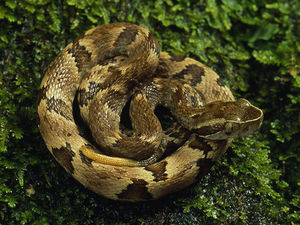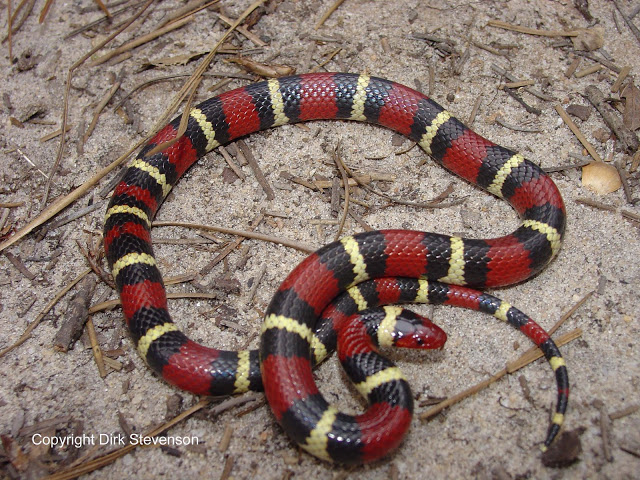Difference between revisions of "Snakes"
m (→Jararaca) |
m (→Jararaca) |
||
| Line 2: | Line 2: | ||
== Jararaca == | == Jararaca == | ||
| − | [[File:Jararaca Snake.jpg|right|300px]] | + | [[File:Jararaca Snake.jpg|right|300px]]One of these was found on our land not long ago, so it's of particular interest. |
| − | The head scalation includes 5-12 intersupraoculars that are weakly keeled, 7-9 supralabials (usually 8) of which the second is fused with the prelacunal to form a lacunolabial, and 9-13 sublabials (usually 10-12). Midbody, there are 20-27 dorsal scales (usually 23-25). The ventrals number 170-216 (rarely 218) and the 51-71 subcaudals are mostly paired. | + | The Jararaca grows to a maximum length of 1.6m, although the average length is much less. The head scalation includes 5-12 intersupraoculars that are weakly keeled, 7-9 supralabials (usually 8) of which the second is fused with the prelacunal to form a lacunolabial, and 9-13 sublabials (usually 10-12). Midbody, there are 20-27 dorsal scales (usually 23-25). The ventrals number 170-216 (rarely 218) and the 51-71 subcaudals are mostly paired. |
The colour pattern is extremely variable, consisting of a dorsal ground colour that may be tan, brown, gray, yellow, olive, or almost maroon. Midbody, this colour is usually somewhat lighter than the head, anterior and posterior. This is overlaid with a series of pale-edged, dark brown subtriangular or trapezoidal markings on either side of the body, the apices of which reach the vertebral line. These marking may be situated opposite each other, or partially or completely juxtaposed; most specimens have a pattern with all three variations. In juveniles, the tip of the tail is white. | The colour pattern is extremely variable, consisting of a dorsal ground colour that may be tan, brown, gray, yellow, olive, or almost maroon. Midbody, this colour is usually somewhat lighter than the head, anterior and posterior. This is overlaid with a series of pale-edged, dark brown subtriangular or trapezoidal markings on either side of the body, the apices of which reach the vertebral line. These marking may be situated opposite each other, or partially or completely juxtaposed; most specimens have a pattern with all three variations. In juveniles, the tip of the tail is white. | ||
Revision as of 23:28, 21 May 2012
We have snakes on our land, so I'd like to start a list of the possible kinds we may encounter and which are dangerous.
Jararaca
One of these was found on our land not long ago, so it's of particular interest.
The Jararaca grows to a maximum length of 1.6m, although the average length is much less. The head scalation includes 5-12 intersupraoculars that are weakly keeled, 7-9 supralabials (usually 8) of which the second is fused with the prelacunal to form a lacunolabial, and 9-13 sublabials (usually 10-12). Midbody, there are 20-27 dorsal scales (usually 23-25). The ventrals number 170-216 (rarely 218) and the 51-71 subcaudals are mostly paired.
The colour pattern is extremely variable, consisting of a dorsal ground colour that may be tan, brown, gray, yellow, olive, or almost maroon. Midbody, this colour is usually somewhat lighter than the head, anterior and posterior. This is overlaid with a series of pale-edged, dark brown subtriangular or trapezoidal markings on either side of the body, the apices of which reach the vertebral line. These marking may be situated opposite each other, or partially or completely juxtaposed; most specimens have a pattern with all three variations. In juveniles, the tip of the tail is white.
The head has a prominent, dark brown stripe that runs from behind the eye on either side of the head back to the angle of the mouth, usually touching the last three supralabials. Dorsally, this stripe is bordered by a distinct pale area. The tongue is black and the iris is gold to greenish gold with slightly darker reticulations.
This snake is found in southern Brazil, northeastern Paraguay and northern Argentina (Misiones). The type locality is listed as "Lagoa d'Arara am Mucurí" (Brazil) by Wied-Neuwied in 1825. Occurs from near sea level to over 1,000m altitude.
The species prefers deciduous tropical forests and savanna country, as well as semitropical upland forests. It is said to favor open areas, such as farmland, with nearby vegetation cover.
This species is often abundant within its range, where it is an important cause of snakebite. It is the best-known venomous snake in the wealthy and heavily populated areas of southeastern Brazil, where is was responsible for 52% (3,446 cases) of snakebite between 1902 and 1945, with a 0.7% mortality rate (25 deaths).
The average venom yield is 25-26mg with a maximum of 300mg of dried venom. The venom is quite toxic. The median lethal dose is estimated to be about 200 mg subcutaneous.
Coral snake
Coral snakes are very poisonous, but are also extremely shy and will escape quickly from any rapid movement or loud noise, they will only attack a human as an absolute last option, so the basic rule when encountering a Coral snake is simply to give it room to get away easily. Coral snakes only accounted for 0.65% of the 75312 bites by venomous snakes in Brazil between 2001 and 2004.
If you are bitten by a Coral snake then a couple of important things to note are firstly that their poison is injected into the victim quite slowly taking up to five seconds, so pulling the snake off quickly and throwing it away can greatly reduce the amount of poison that enters the body. Secondly, the poison takes a few hours or more to begin taking effect, so you have plenty of time to get to a hospital, but make it a top priority because once the venom starts to take effect, it can prevent you from breathing.
Adult Coral snakes are usually 65 to 85 cm long, but can be up to 1.5m. They have a reddish body with 11-14 triads of black rings, tail short (with less than 2 full triads). Snout and chin white (usually with scales edged with black; and often with black spots), head with wide red band around middle. Dorsal junctions of red and black rings looks "jagged" because scale tend to be all red or all black. One pair of fixed, upper, front fangs.
They're limited to southeastern and south-central Brazil and found mainly in deciduous subtropical and tropical forests, cerrado savannas, and scrub-palm associations; from near sea level to about 600m elevation.









